How to Use Oils for Varicose Veins
To maximize benefits and minimize risks, follow these usage guidelines:
-
Dilution: Always mix essential oils with a carrier oil such as jojoba, coconut, sweet almond, or olive oil before applying to skin to avoid irritation. Common dilutions are about 2-3% essential oil (e.g., 10-12 drops per 1 ounce of carrier oil).
-
Massage: Gently massage the diluted oil blend on affected legs using upward strokes toward the heart to promote circulation. Perform twice daily for best results.
-
Compresses: Soak a clean cloth in a mixture of water and essential oils (about 5 drops per liter), wring it out, apply to the varicose veins, and keep legs elevated for 15 minutes. Alternate between warm and cool compresses to reduce swelling.
-
Baths: Add 5-8 drops of essential oils to warm bathwater and soak for 15-20 minutes to relax muscles and improve circulation.
-
Aromatherapy: Inhalation of essential oils like lavender may reduce pain perception and promote relaxation but is supplementary rather than direct treatment.
Safety Considerations
-
Test essential oil blends on a small patch of skin before full use to check for allergic reactions like redness, irritation, or rash.
-
Avoid applying essential oils undiluted directly to skin.
-
Consult a healthcare professional before use if you are pregnant, breastfeeding, have high blood pressure, skin conditions, or are on medications.
-
Some oils (like citrus-based oils) can increase sensitivity to sunlight; avoid sun exposure immediately after application.
Complementary Lifestyle Tips for Varicose Veins
Oils work best alongside lifestyle adjustments:
-
Elevate legs when resting to reduce blood pooling.
-
Avoid prolonged standing or sitting; move regularly to improve circulation.
-
Wear compression stockings if recommended by a doctor.
-
Maintain a healthy weight and diet rich in fiber, vitamins C and E, to support vein health.
-
Stay hydrated and avoid constrictive clothing.








Reviews
There are no reviews yet.